Climate Sensitivity
IPCC
The very first 1990 IPCC assessment used the full range of 3 different climate sensitivities in projections of global warming, namely 1.5C 2.5C and 3.5C.
"IPCC AR4 2007 It is likely to be in the range 2°C to 4.5°C with a best estimate of about 3°C, and is very unlikely to be less than 1.5°C. Values substantially higher than 4.5°C cannot be excluded...
Andronova and Schlesinger (2001) found that the climate sensitivity could lie between 1 and 10 °C, with a 54 percent likelihood that it lies outside the IPCC range.
The very first 1990 IPCC assessment used the full range of 3 different climate sensitivities in projections of global warming, namely 1.5C 2.5C and 3.5C.
"IPCC AR4 2007 It is likely to be in the range 2°C to 4.5°C with a best estimate of about 3°C, and is very unlikely to be less than 1.5°C. Values substantially higher than 4.5°C cannot be excluded...
Andronova and Schlesinger (2001) found that the climate sensitivity could lie between 1 and 10 °C, with a 54 percent likelihood that it lies outside the IPCC range.
8.6.2.3.
Throughout the last three IPCC
assessments, climate models exhibit a wide range of climate sensitivity
estimates.
Spread in model climate sensitivity is a
major factor contributing to the range in projections of future climate
changes along with uncertainties in future emission
scenarios and rates of oceanic heat uptake.
The GCMs all predict a positive cloud feedback, but strongly disagree on its magnitude."
IPCC computer model probability distribution of of climate sensitivity.
IPCC AR4 2007
The IPCC's fast feedback CS has a huge range mainly because the scientists differ on how they treat cloud feedback. None of them include amplifying carbon feedbacks
Webb et al. (2006) Investigating a selection of the slab versions of models found that differences in feedbacks contribute almost three times more to the range in equilibrium climate sensitivity estimates than differences in the models' radioactive forcing.
"Climate sensitivity is a key uncertainty for mitigation scenarios for specific temperature levels."
http://www.ipcc.ch/publicationsanddata/ar4/syr/en/spms5.html
The IPCC's fast feedback CS has a huge range mainly because the scientists differ on how they treat cloud feedback. None of them include amplifying carbon feedbacks
Webb et al. (2006) Investigating a selection of the slab versions of models found that differences in feedbacks contribute almost three times more to the range in equilibrium climate sensitivity estimates than differences in the models' radioactive forcing.
"Climate sensitivity is a key uncertainty for mitigation scenarios for specific temperature levels."
http://www.ipcc.ch/publicationsanddata/ar4/syr/en/spms5.html
http://www.ipcc.ch/publications_and_data/ar4/wg1/en/ch8s8-6.html IPCC text below
The single climate sensitivity metric used by the IPCC has a huge upper range. It is not accounted for in the IPCC projections of the 'most likely' temperature increases, that just takes the mean of the wide range of computer model results.
It is in fact an extremely dangerous wide range and the higher temperature increase the greater is the potential upper range error.
The latest IPCC models giving the mean sensitivity of 3C, also give a 14% chance the metric exceeds 4.5C. (Global warming under old and new scenarios using IPCC climate sensitivity range estimates Rogelj Malte Meinshausen Reto Knutti Feb 2012)
(The climate sensitivity applies only to atmospheric carbon dioxide. The scientists assume that the sensitivity to the atmospheric CO2 equivalent is the same as for CO2 alone.)
"8.6.3 The traditional approach in assessing model sensitivity has to consider water vapour, lapse rate, surface albedo and cloud feedbacks separately. Although this division can be regarded as somewhat artificial, because for example, water vapour, clouds and temperature interact strongly, it remains conceptually useful.
8.6.3.2.4 Despite some advances in the understanding of the physical processes that control the cloud response to climate change and in the evaluation of some components of cloud feedbacks in current models, it is not yet possible to assess which of the model estimates of cloud feedback is the most reliable.
8.6.3.3 The role of sea ice dynamics in climate sensitivity has remained uncertain for years.
8.6.4 A set of model metrics that might be used to narrow the range of plausible climate change has yet to be developed"
"8.6.3 The traditional approach in assessing model sensitivity has to consider water vapour, lapse rate, surface albedo and cloud feedbacks separately. Although this division can be regarded as somewhat artificial, because for example, water vapour, clouds and temperature interact strongly, it remains conceptually useful.
8.6.3.2.4 Despite some advances in the understanding of the physical processes that control the cloud response to climate change and in the evaluation of some components of cloud feedbacks in current models, it is not yet possible to assess which of the model estimates of cloud feedback is the most reliable.
8.6.3.3 The role of sea ice dynamics in climate sensitivity has remained uncertain for years.
8.6.4 A set of model metrics that might be used to narrow the range of plausible climate change has yet to be developed"
Fast (onset) and slow (onset) feedback sensitivity.
The fast onset feedbacks are the ones that immediately act in response to an increase in atmospheric greenhouse gases (GHGs). They are mainly atmospheric feedbacks in the air, like water vapor, clouds and minute suspended particles (aerosols). Some albedo cooling effect of snow and ice is included.
Water vapor is actually the main GHG because it is so abundant but its global warming effect is mainly a feedback response. Warm air holds more water vapor and that about doubles the warming caused just by a GHG increase.
Slow onset feedbacks are planetary responses to global warming like melting ice sheets and thawing permafrost. Warming wetland peat is a slow feedbacks and melting sub seafloor methane hydrate is considered a very slow feedback.
The fast feedback CS is taken to be 3 by the scientists and the slow feedback sensitivity is not used in the assessments- a huge error in underestimating the actual warming that will occur over the long term future.
The IPCC graph opposite shows the calculation of projected warming calculated from the fast CS of 3 (at 2009). The CO2 equivalent is the main 3 GHGs expressed in terms of CO2. The 2012 concentration is 490 and leads to a mean warming of 2.25C which is catastrophic and so we are a planetary emergency. However over time that 2.25C will trigger feedbacks like the loss of the Arctic sea ice and snow and Arctic methane emissions that will push the warming up to 5C- all caused by today's atmospheric CO2 eq. While some poorly informed people may think we could adapt to a 2.25 warming, 5C is definitely an end of the world warming- leaving no doubt we are at planetary emergency.
It was James Hansen who pointed out in a 2008 paper that the true climate sensitivity for the very long term is (6C), which is double the immediate fast feedback sensitivity (3C) that has been applied by the science since the first IPCC assessment in 1990.
It is the 'true' CS because it is protective of all future generations and life. The fast CS that does not include the large slow feedbacks is not protective. The slow FS is therefore by far the most policy relevant.
Slow feedbacks take a long time (hence 'slow') in response to global warming, but they greatly increase over time and are irreversible. They are loss of albedo cooling from ice melting and Arctic carbon feedbacks from warming wetlands and thawing permafrost, that release methane and carbon dioxide.
There is little point in debating the precise number of the fast CS that is the only CS being used, when we are ignoring all important slow CS.
The debate is because the climate sensitivity fast feedback being used has a very large range, that has actually not changed significantly since 1990.
"The long term change in surface air temperature following a doubling of carbon dioxide (referred to as the climate sensitivity) is generally used as a benchmark to compare models. The range of results from model studies is 1.9 to 5.2°C... the models results do not justify altering the previously accepted range of 1.5 to 4.5°C. (IPCC WG 1 1990)
It is likely to be in the range 2°C to 4.5°C with a best estimate of about 3°C, (IPCC WG1 AR4 2007)"
The single fast feedback CS metric (3) as defined and applied by climate change science ignores the greatest global warming risk which is runaway climate change from large Arctic +ve (amplifying) slow feedbacks.
The metric is fixed to allow for climate change modeling. However in the real world the climate sensitivity is dynamic - with warming it increases as does the risk of abrupt warming.
There are wide ranges of uncertainty for all aspects of climate change modeling (IPCC 2007), and there is a wide range of uncertainty for the fast climate sensitivity that determines the entire assessment of climate change.
The IPCC only addresses the fast feedbacks, not the very large delayed slow feedbacks that lead to much more warming over time and can cause abrupt climate change.
"... climate sensitivity only considers the surface mean temperature and gives no indication of the occurrence of abrupt changes or extreme events. Despite its limitations, however, the climate sensitivity remains a useful concept.. IPCC AR4 2007 8.6.2.1 Definition of Climate Sensitivity"
The fact is climate sensitivity is not a linear constant factor (as is the case in the science), it is dynamic increasing with time and temperature of warming. This is because of the many positive (bad) feedbacks that increase with warming.
Fast (onset) and slow (onset) feedback sensitivity.
The fast onset feedbacks are the ones that immediately act in response to an increase in atmospheric greenhouse gases (GHGs). They are mainly atmospheric feedbacks in the air, like water vapor, clouds and minute suspended particles (aerosols). Some albedo cooling effect of snow and ice is included.
Water vapor is actually the main GHG because it is so abundant but its global warming effect is mainly a feedback response. Warm air holds more water vapor and that about doubles the warming caused just by a GHG increase.
Slow onset feedbacks are planetary responses to global warming like melting ice sheets and thawing permafrost. Warming wetland peat is a slow feedbacks and melting sub seafloor methane hydrate is considered a very slow feedback.
The fast feedback CS is taken to be 3 by the scientists and the slow feedback sensitivity is not used in the assessments- a huge error in underestimating the actual warming that will occur over the long term future.
The IPCC graph opposite shows the calculation of projected warming calculated from the fast CS of 3 (at 2009). The CO2 equivalent is the main 3 GHGs expressed in terms of CO2. The 2012 concentration is 490 and leads to a mean warming of 2.25C which is catastrophic and so we are a planetary emergency. However over time that 2.25C will trigger feedbacks like the loss of the Arctic sea ice and snow and Arctic methane emissions that will push the warming up to 5C- all caused by today's atmospheric CO2 eq. While some poorly informed people may think we could adapt to a 2.25 warming, 5C is definitely an end of the world warming- leaving no doubt we are at planetary emergency.
It was James Hansen who pointed out in a 2008 paper that the true climate sensitivity for the very long term is (6C), which is double the immediate fast feedback sensitivity (3C) that has been applied by the science since the first IPCC assessment in 1990.
It is the 'true' CS because it is protective of all future generations and life. The fast CS that does not include the large slow feedbacks is not protective. The slow FS is therefore by far the most policy relevant.
Slow feedbacks take a long time (hence 'slow') in response to global warming, but they greatly increase over time and are irreversible. They are loss of albedo cooling from ice melting and Arctic carbon feedbacks from warming wetlands and thawing permafrost, that release methane and carbon dioxide.
There is little point in debating the precise number of the fast CS that is the only CS being used, when we are ignoring all important slow CS.
The debate is because the climate sensitivity fast feedback being used has a very large range, that has actually not changed significantly since 1990.
"The long term change in surface air temperature following a doubling of carbon dioxide (referred to as the climate sensitivity) is generally used as a benchmark to compare models. The range of results from model studies is 1.9 to 5.2°C... the models results do not justify altering the previously accepted range of 1.5 to 4.5°C. (IPCC WG 1 1990)
It is likely to be in the range 2°C to 4.5°C with a best estimate of about 3°C, (IPCC WG1 AR4 2007)"
The single fast feedback CS metric (3) as defined and applied by climate change science ignores the greatest global warming risk which is runaway climate change from large Arctic +ve (amplifying) slow feedbacks.
The metric is fixed to allow for climate change modeling. However in the real world the climate sensitivity is dynamic - with warming it increases as does the risk of abrupt warming.
There are wide ranges of uncertainty for all aspects of climate change modeling (IPCC 2007), and there is a wide range of uncertainty for the fast climate sensitivity that determines the entire assessment of climate change.
The IPCC only addresses the fast feedbacks, not the very large delayed slow feedbacks that lead to much more warming over time and can cause abrupt climate change.
"... climate sensitivity only considers the surface mean temperature and gives no indication of the occurrence of abrupt changes or extreme events. Despite its limitations, however, the climate sensitivity remains a useful concept.. IPCC AR4 2007 8.6.2.1 Definition of Climate Sensitivity"
The fact is climate sensitivity is not a linear constant factor (as is the case in the science), it is dynamic increasing with time and temperature of warming. This is because of the many positive (bad) feedbacks that increase with warming.
Very large
slow feedbacks
not included
These are cause of runaway heating planetary catsrophe
slow feedbacks
not included
These are cause of runaway heating planetary catsrophe
'Terrestrial'
carbon feedbacks not included in the fast feedback 3C climate sensitivity.
These will add to the rate of warming this century
- Soil respiration CO2
- Vegetation CO2
- Forest fires CO2
- Amazon forest die back
- Reduced capacity of CO2 uptake by oceans.
- Ice sheet disintegration,
- vegetation migration,
- GHG release from peatlands & tundra,
- GHGs from thawing permafrost, and melting subsea methane hydrates
- widespread changes in ocean circulation
- failure of the ocean carbon pump.
The IPCC still uses only one fixed metric for climate sensitivity (3C) , which leads to a large under-estimate of the projected real world long term warming.
The extent of the underestimate increases with global temperature and over time.
The true real Earth system climate sensitivity is 6C which is double the metric still being used (which is the same as the first 1990 IPCC assessment at 3C).
The very first 1990 IPCC assessment used the full range of 3 different climate sensitivities in projections of global warming, namely 1.5C 2.5C and 3.5C. This observed that the sensitivity was first used to compare the large variation in projecting model results and till recently the IPCC has always said these model projections are not predictions (quote is below).
The climate sensitivity of 3C is does not protect us from future disastrous and catastrophic impacts of climate change that will happen with rising degrees of global warming.
The state of planetary emergency that we are in (and ignoring), is in large part be due to the fact that we have greatly under estimated the real world long-term 'climate sensitivity' of the planet to increasing long lasting atmospheric greenhouse gases.
The climate sensitivity is understood to be simply how much the planet's temperature will increase by greenhouse gases being added to the atmosphere - specifically it has been defined as the full very long term (equilibrium) warming caused by a doubling of atmospheric CO2.
Climate sensitivity is largely due to feedbacks. The warming caused directly by GHG emissions is only a fraction of the warming that results- because of feedbacks caused by the GHG warming.
All climate change science rests on one calculation- a single climate sensitivity, which defined as the full eventual long term (equilibrium) global warming that would result from a doubling of atmospheric carbon dioxide.
The IPCC says the best estimate is 3C (for 2X atmospheric CO2), and all science has always only used this one metric in research and assessing future climate change.
However in its comprehensive technical mitigation report the IPCC 2007 assessment clearly explained that relying on only one 'best estimate' climate sensitivity for projecting all temperature increases is climate change science enormously risky (see below).
It is plain wrong - a huge totally unacceptable risk. Mitigation measures based on the single climate sensitivity of 3C will be hopelessly inadequate for preventing global climate planetary catastrophe.
The IPCC explains In a risk-management framework, a first step to understanding the environmental consequences of mitigation strategies is to look at links between various stabilization levels for concentrations of greenhouse gases in the atmosphere, and the global mean temperature change relative to a particular baseline.
A second step is to link levels of temperature change and key vulnerabilities. Climate models indicate significant uncertainty at both levels.
For example, respecting constraints of 2°C above pre-industrial levels, at equilibrium, is already outside the range of scenarios considered in this chapter, if the higher values of likely climate sensitivity are taken into account (red curve in Figure 3.38), whilst a constraint of respecting 3°C above pre-industrial levels implies the most stringent of the category I scenarios, with emissions peaking in no more than the next 10 years, again if the higher likely values of climate sensitivity are taken into account. Using the ‘best estimate’ of climate sensitivity as a guide for establishing targets, implies the need for less stringent emission constraints. This ‘best estimate’ assumption shows that the most stringent (category I) scenarios could limit global mean temperature increases to 2°C–2.4°C above pre-industrial levels, at equilibrium, requiring emissions to peak within 10 years. Similarly, limiting temperature increases to 2°C above pre-industrial levels can only be reached at the lowest end of the concentration interval found in the scenarios of category I (i.e. about 450 ppmv CO2-eq using ‘best estimate’ assumptions). By comparison, using the same ‘best estimate’ assumptions, category II scenarios could limit the increase to 2.8°C–3.2°C above pre-industrial levels at equilibrium, requiring emissions to peak within the next 25 years, whilst category IV scenarios could limit the increase to 3.2°C–4°C above pre-industrial at equilibrium requiring emissions to peak within the next 55 years. Note that category IV scenarios could result in temperature increases as high as 6.1°C above pre-industrial levels, when the likely range for the value of climate sensitivity is taken into account. Hence, setting policy on the basis of a ‘best estimate’ climate sensitivity accepts a significant risk of exceeding the temperature thresholds,IPCC 2007 WG 3 tech report 3.5.2 Linking emission scenarios to changes in global mean temperature, impacts and key vulnerabilities since the climate sensitivity could be higher than the best estimate.
IPCC (2007a) finds that the climate sensitivity is likely to be in the range 2°C –4.5°C ...
Non-linearities in the feedbacks (including e.g. ice cover and carbon cycle) may cause time dependence of the effective climate sensitivity, as well as leading to larger uncertainties for greater warming levels."
There is great uncertainty of the upper limit for sensitivity, so it is not right to apply only one number and the mean at that. This excludes any risk of the sensitivity being above 3C to any degree. That is a difference between possible avoiding planetary catastrophe and impossible.
Using only atmospheric CO2 is odd because we need to know the warming from a doubling of atmospheric CO2 equivalent, because that includes methane and nitrous oxide and is about 100ppm higher than CO2.
It is a shocking only recently realized fact of the science that we are using a climate sensitivity that is only half what the real world number is.
For over 20 years the climate sensitivity has been assumed to be 3, but now we know it is above 3C and up to 6C.
There are in fact two climate sensitivities that have calculated by science. The only one used only includes immediate acting fast (onset) feedbacks. The other adds in large slow (onset) feedbacks that only happen as a result of global warming (more further on).
The knowledge of a much higher sensitivity first became known to the general climate change community through a James Hansen led 2008 paper Target CO2. This became known as the 350ppm CO2 paper.
In this paper Dr Hansen reduced his estimate of the global warming danger limit from 1.6C to 1.C leading to the target of atmospheric CO2 below 350 ppm. The reason was he found that by combining past records like ice cores with climate models that the long term climate sensitivity is 6C not 3C. He includes the fact that we must account for methane and nitrous oxide in estimating sensitivity as well as the CO2 that is only applied for the 3 sensitivity.
"Abstract: Paleoclimate data show that climate sensitivity is ~3°C for doubled CO2, including only fast feedback processes. Equilibrium sensitivity, including slower surface albedo feedbacks, is ~6°C for doubled CO2 for the range of climate states between glacial conditions and ice-free Antarctica. If humanity wishes to preserve a planet similar to that on which civilization developed and to which life on Earth is adapted, paleoclimate evidence and ongoing climate change suggest that CO2 will need to be reduced from its current 385 ppm to at most 350 ppm, but likely less than that. If the present overshoot of this target CO2 (350 ppm) is not brief, there is a possibility of seeding irreversible catastrophic effects."
Dr Hansen has since led other papers concluding long term equilibrium sensitivity is 6C and the danger is limit is 1C.
In a September 2013 paper Climate Sensitivity, Sea Level, and Atmospheric CO2 Dr Hansen addressed the fast feedback sensitivity in a similar manner, finding it is at the upper end of the IPCC range i.e 3C to 4.5C, and not 3C.
"Glacial-to-interglacial climate change ... implies a sensitivity in the upper part of the above range, i.e., 3-4°C."
A Feb 2013 time-dependent climate sensitivity and the legacy of anthropogenic greenhouse gas emissions is found that sensitivity is much higher than 3C.
Here, I introduce the time-dependent climate sensitivity, which unifies fast-feedback and Earth system sensitivity.
I show that warming projections, which include a time-dependent climate sensitivity, exhibit an enhanced feedback between surface warming and ocean CO2 solubility, which in turn leads to higher atmospheric CO2 levels and further warming.
The abstract of a July 2013 paper really says it all Review Article Climate sensitivity in the Anthropocene.
"Climate sensitivity in its most basic form is defined as the equilibrium change in global surface temperature that occurs in response to a climate forcing, or externally imposed perturbation of the planetary energy balance.Within this general definition, several specific forms of climate sensitivity exist that differ in terms of the types of climate feedbacks they include. Based on evidence from Earth’s history, we suggest here that the relevant form of climate sensitivity in the Anthropocene (e.g. from which to base future greenhouse gas (GHG) stabilization targets) is the
Earth system sensitivity including fast feedbacks from changes in water vapour, natural aerosols,clouds and sea ice, slower surface albedo feedbacks from changes in continental icesheets and vegetation, and climate–GHG feedbacks from changes in natural (land and ocean) carbon sinks. Traditionally, only fast feedbacks have been considered (with the other feedbacks either ignored or treated as forcing), which has led to estimates of the climate sensitivity for doubled CO2 concentrations of about 3◦C.
The 2×CO2 Earth system sensitivity is higher than this (3C), being ∼4–6◦C if the ice sheet/vegetation albedo feedback is included in addition to the fast feedbacks, and higher still if climate–GHG feedbacks are also included.
The inclusion of climate–GHG feedbacks due to changes in the natural carbon sinks has the advantage of more directly linking anthropogenic GHG emissions with the ensuing global temperature increase, thus providing a truer indication of the climate sensitivity to human perturbations."
The extent of the underestimate increases with global temperature and over time.
The true real Earth system climate sensitivity is 6C which is double the metric still being used (which is the same as the first 1990 IPCC assessment at 3C).
The very first 1990 IPCC assessment used the full range of 3 different climate sensitivities in projections of global warming, namely 1.5C 2.5C and 3.5C. This observed that the sensitivity was first used to compare the large variation in projecting model results and till recently the IPCC has always said these model projections are not predictions (quote is below).
The climate sensitivity of 3C is does not protect us from future disastrous and catastrophic impacts of climate change that will happen with rising degrees of global warming.
The state of planetary emergency that we are in (and ignoring), is in large part be due to the fact that we have greatly under estimated the real world long-term 'climate sensitivity' of the planet to increasing long lasting atmospheric greenhouse gases.
The climate sensitivity is understood to be simply how much the planet's temperature will increase by greenhouse gases being added to the atmosphere - specifically it has been defined as the full very long term (equilibrium) warming caused by a doubling of atmospheric CO2.
Climate sensitivity is largely due to feedbacks. The warming caused directly by GHG emissions is only a fraction of the warming that results- because of feedbacks caused by the GHG warming.
All climate change science rests on one calculation- a single climate sensitivity, which defined as the full eventual long term (equilibrium) global warming that would result from a doubling of atmospheric carbon dioxide.
The IPCC says the best estimate is 3C (for 2X atmospheric CO2), and all science has always only used this one metric in research and assessing future climate change.
However in its comprehensive technical mitigation report the IPCC 2007 assessment clearly explained that relying on only one 'best estimate' climate sensitivity for projecting all temperature increases is climate change science enormously risky (see below).
It is plain wrong - a huge totally unacceptable risk. Mitigation measures based on the single climate sensitivity of 3C will be hopelessly inadequate for preventing global climate planetary catastrophe.
The IPCC explains In a risk-management framework, a first step to understanding the environmental consequences of mitigation strategies is to look at links between various stabilization levels for concentrations of greenhouse gases in the atmosphere, and the global mean temperature change relative to a particular baseline.
A second step is to link levels of temperature change and key vulnerabilities. Climate models indicate significant uncertainty at both levels.
For example, respecting constraints of 2°C above pre-industrial levels, at equilibrium, is already outside the range of scenarios considered in this chapter, if the higher values of likely climate sensitivity are taken into account (red curve in Figure 3.38), whilst a constraint of respecting 3°C above pre-industrial levels implies the most stringent of the category I scenarios, with emissions peaking in no more than the next 10 years, again if the higher likely values of climate sensitivity are taken into account. Using the ‘best estimate’ of climate sensitivity as a guide for establishing targets, implies the need for less stringent emission constraints. This ‘best estimate’ assumption shows that the most stringent (category I) scenarios could limit global mean temperature increases to 2°C–2.4°C above pre-industrial levels, at equilibrium, requiring emissions to peak within 10 years. Similarly, limiting temperature increases to 2°C above pre-industrial levels can only be reached at the lowest end of the concentration interval found in the scenarios of category I (i.e. about 450 ppmv CO2-eq using ‘best estimate’ assumptions). By comparison, using the same ‘best estimate’ assumptions, category II scenarios could limit the increase to 2.8°C–3.2°C above pre-industrial levels at equilibrium, requiring emissions to peak within the next 25 years, whilst category IV scenarios could limit the increase to 3.2°C–4°C above pre-industrial at equilibrium requiring emissions to peak within the next 55 years. Note that category IV scenarios could result in temperature increases as high as 6.1°C above pre-industrial levels, when the likely range for the value of climate sensitivity is taken into account. Hence, setting policy on the basis of a ‘best estimate’ climate sensitivity accepts a significant risk of exceeding the temperature thresholds,IPCC 2007 WG 3 tech report 3.5.2 Linking emission scenarios to changes in global mean temperature, impacts and key vulnerabilities since the climate sensitivity could be higher than the best estimate.
IPCC (2007a) finds that the climate sensitivity is likely to be in the range 2°C –4.5°C ...
Non-linearities in the feedbacks (including e.g. ice cover and carbon cycle) may cause time dependence of the effective climate sensitivity, as well as leading to larger uncertainties for greater warming levels."
There is great uncertainty of the upper limit for sensitivity, so it is not right to apply only one number and the mean at that. This excludes any risk of the sensitivity being above 3C to any degree. That is a difference between possible avoiding planetary catastrophe and impossible.
Using only atmospheric CO2 is odd because we need to know the warming from a doubling of atmospheric CO2 equivalent, because that includes methane and nitrous oxide and is about 100ppm higher than CO2.
It is a shocking only recently realized fact of the science that we are using a climate sensitivity that is only half what the real world number is.
For over 20 years the climate sensitivity has been assumed to be 3, but now we know it is above 3C and up to 6C.
There are in fact two climate sensitivities that have calculated by science. The only one used only includes immediate acting fast (onset) feedbacks. The other adds in large slow (onset) feedbacks that only happen as a result of global warming (more further on).
The knowledge of a much higher sensitivity first became known to the general climate change community through a James Hansen led 2008 paper Target CO2. This became known as the 350ppm CO2 paper.
In this paper Dr Hansen reduced his estimate of the global warming danger limit from 1.6C to 1.C leading to the target of atmospheric CO2 below 350 ppm. The reason was he found that by combining past records like ice cores with climate models that the long term climate sensitivity is 6C not 3C. He includes the fact that we must account for methane and nitrous oxide in estimating sensitivity as well as the CO2 that is only applied for the 3 sensitivity.
"Abstract: Paleoclimate data show that climate sensitivity is ~3°C for doubled CO2, including only fast feedback processes. Equilibrium sensitivity, including slower surface albedo feedbacks, is ~6°C for doubled CO2 for the range of climate states between glacial conditions and ice-free Antarctica. If humanity wishes to preserve a planet similar to that on which civilization developed and to which life on Earth is adapted, paleoclimate evidence and ongoing climate change suggest that CO2 will need to be reduced from its current 385 ppm to at most 350 ppm, but likely less than that. If the present overshoot of this target CO2 (350 ppm) is not brief, there is a possibility of seeding irreversible catastrophic effects."
Dr Hansen has since led other papers concluding long term equilibrium sensitivity is 6C and the danger is limit is 1C.
In a September 2013 paper Climate Sensitivity, Sea Level, and Atmospheric CO2 Dr Hansen addressed the fast feedback sensitivity in a similar manner, finding it is at the upper end of the IPCC range i.e 3C to 4.5C, and not 3C.
"Glacial-to-interglacial climate change ... implies a sensitivity in the upper part of the above range, i.e., 3-4°C."
A Feb 2013 time-dependent climate sensitivity and the legacy of anthropogenic greenhouse gas emissions is found that sensitivity is much higher than 3C.
Here, I introduce the time-dependent climate sensitivity, which unifies fast-feedback and Earth system sensitivity.
I show that warming projections, which include a time-dependent climate sensitivity, exhibit an enhanced feedback between surface warming and ocean CO2 solubility, which in turn leads to higher atmospheric CO2 levels and further warming.
The abstract of a July 2013 paper really says it all Review Article Climate sensitivity in the Anthropocene.
"Climate sensitivity in its most basic form is defined as the equilibrium change in global surface temperature that occurs in response to a climate forcing, or externally imposed perturbation of the planetary energy balance.Within this general definition, several specific forms of climate sensitivity exist that differ in terms of the types of climate feedbacks they include. Based on evidence from Earth’s history, we suggest here that the relevant form of climate sensitivity in the Anthropocene (e.g. from which to base future greenhouse gas (GHG) stabilization targets) is the
Earth system sensitivity including fast feedbacks from changes in water vapour, natural aerosols,clouds and sea ice, slower surface albedo feedbacks from changes in continental icesheets and vegetation, and climate–GHG feedbacks from changes in natural (land and ocean) carbon sinks. Traditionally, only fast feedbacks have been considered (with the other feedbacks either ignored or treated as forcing), which has led to estimates of the climate sensitivity for doubled CO2 concentrations of about 3◦C.
The 2×CO2 Earth system sensitivity is higher than this (3C), being ∼4–6◦C if the ice sheet/vegetation albedo feedback is included in addition to the fast feedbacks, and higher still if climate–GHG feedbacks are also included.
The inclusion of climate–GHG feedbacks due to changes in the natural carbon sinks has the advantage of more directly linking anthropogenic GHG emissions with the ensuing global temperature increase, thus providing a truer indication of the climate sensitivity to human perturbations."
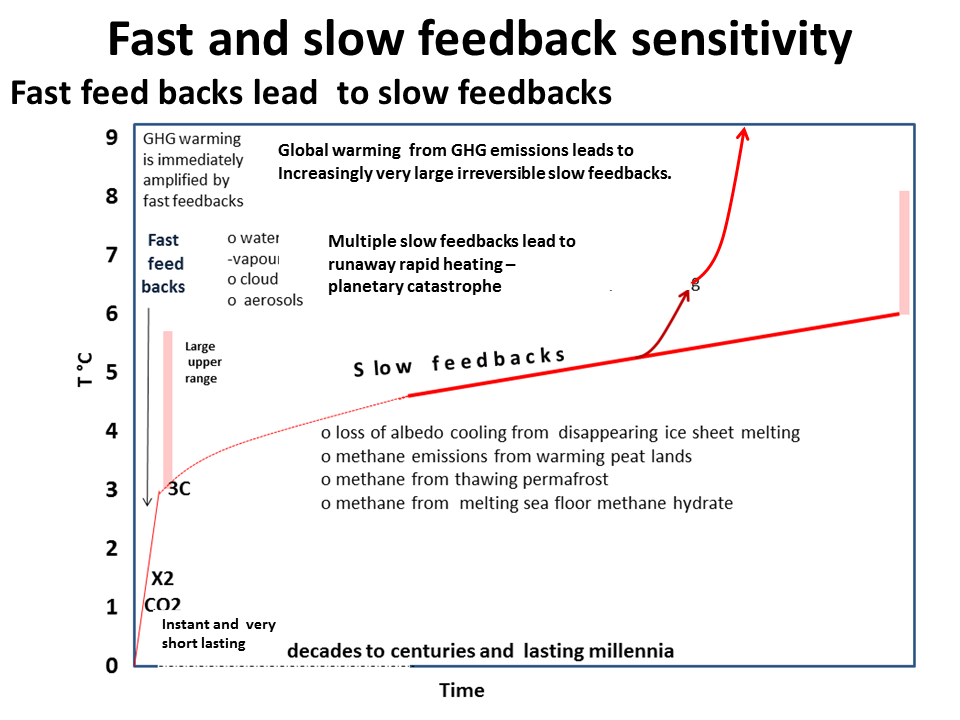
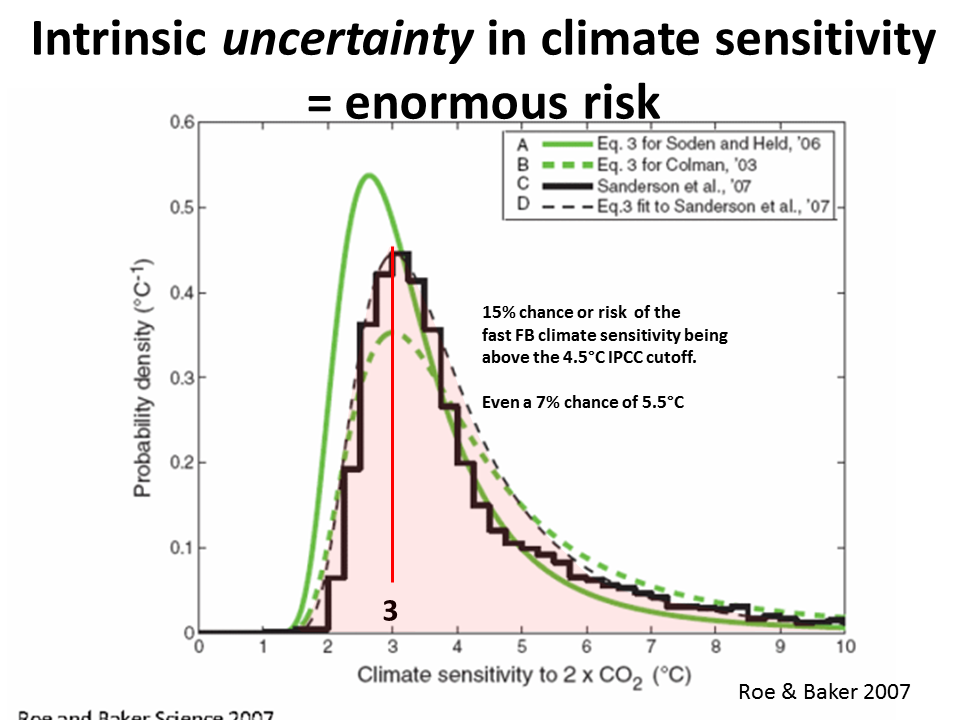
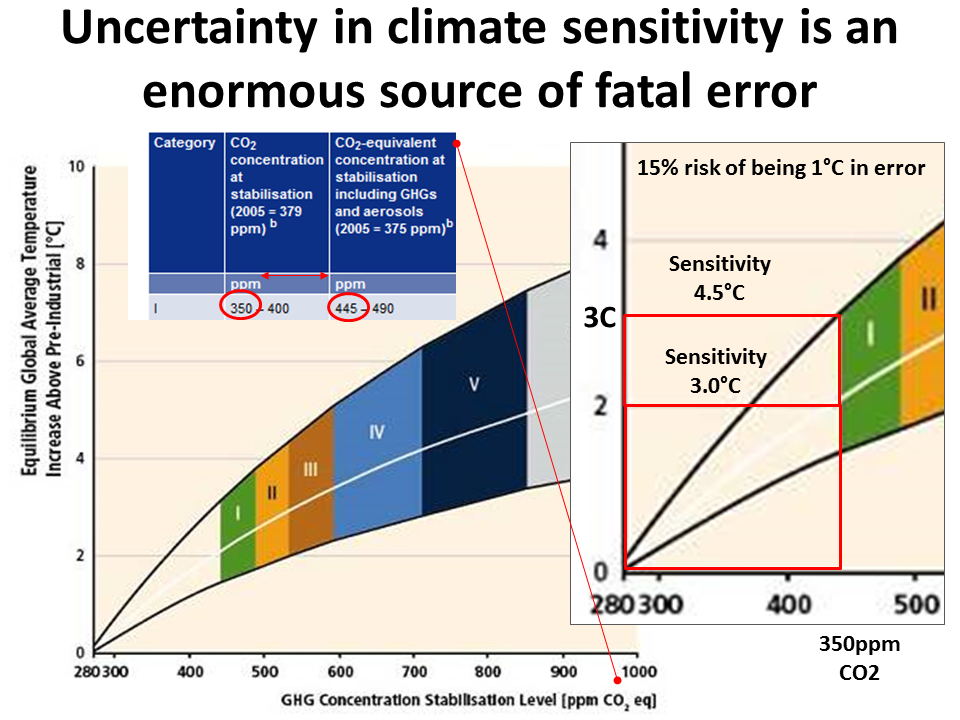
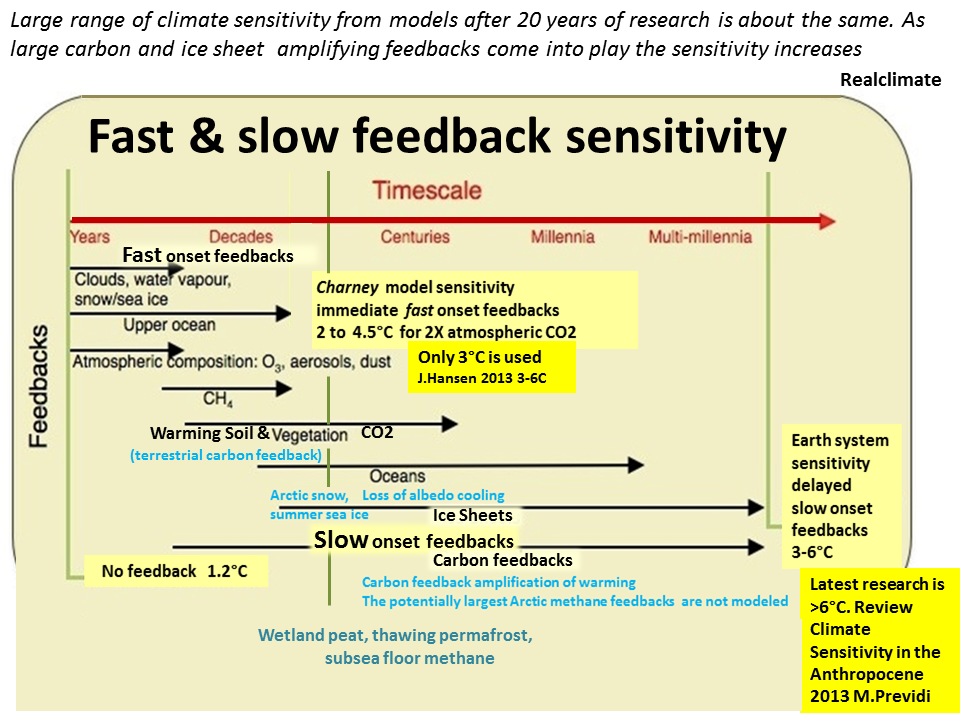
Fast feedbacks
- water vapour,
- surface albedo
- clouds,
- aerosols
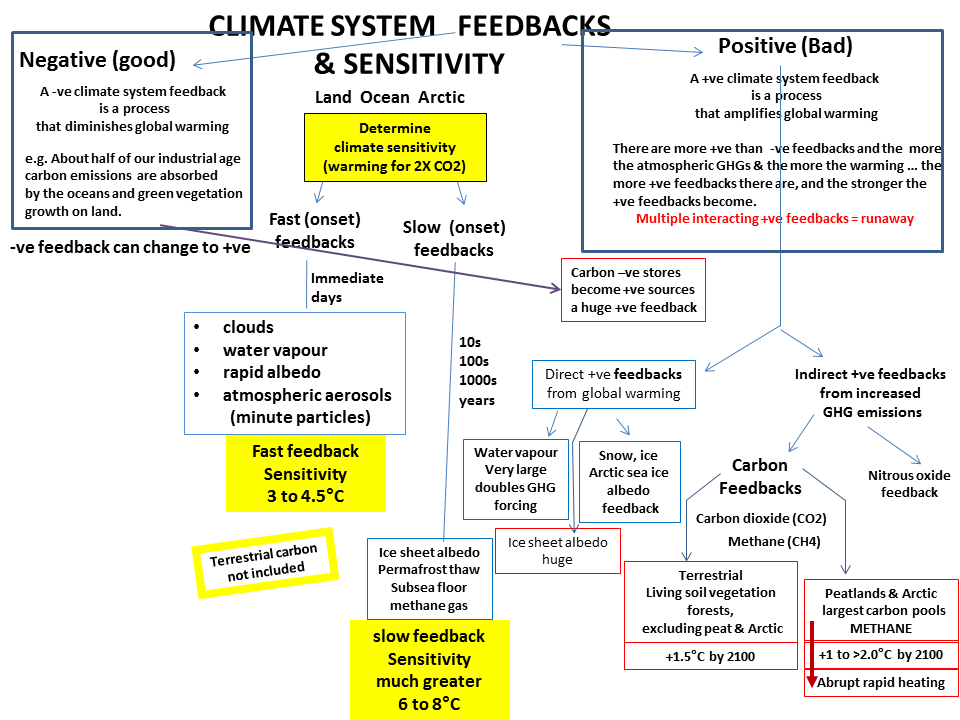
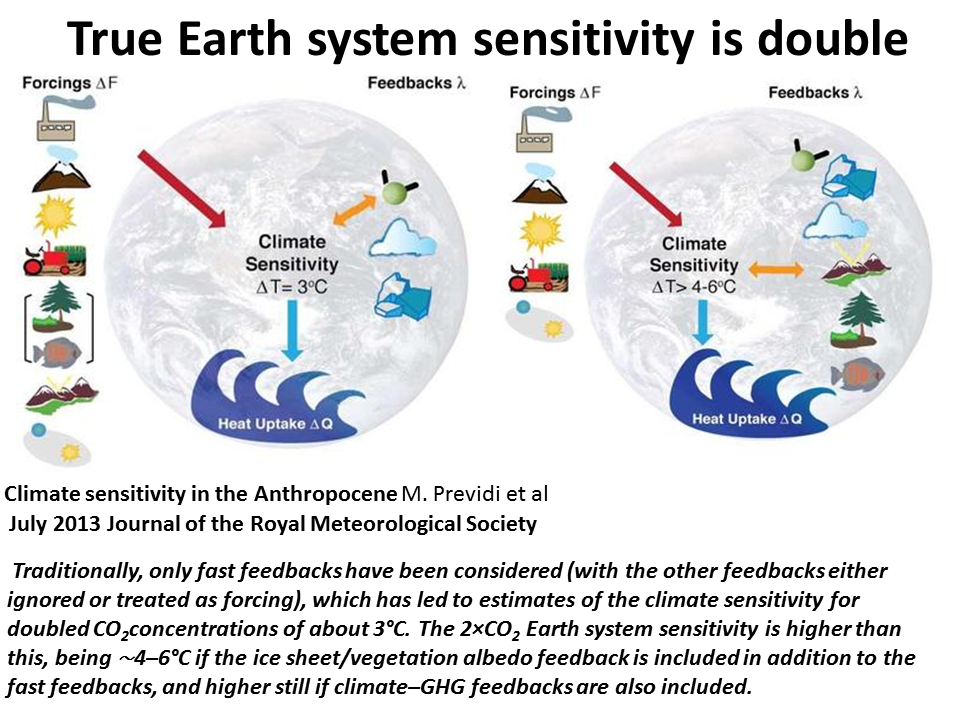
Oct 2013 Discovery that agricultural practices help form clouds could change the way we calculate global warming- climate is more sensitive.
Feb 2013 Time-dependent climate sensitivity(higher) & legacy of GHG emissions (last (23,000–165,000 yrs)
Feb 2013 Time-dependent climate sensitivity(higher) & legacy of GHG emissions (last (23,000–165,000 yrs)
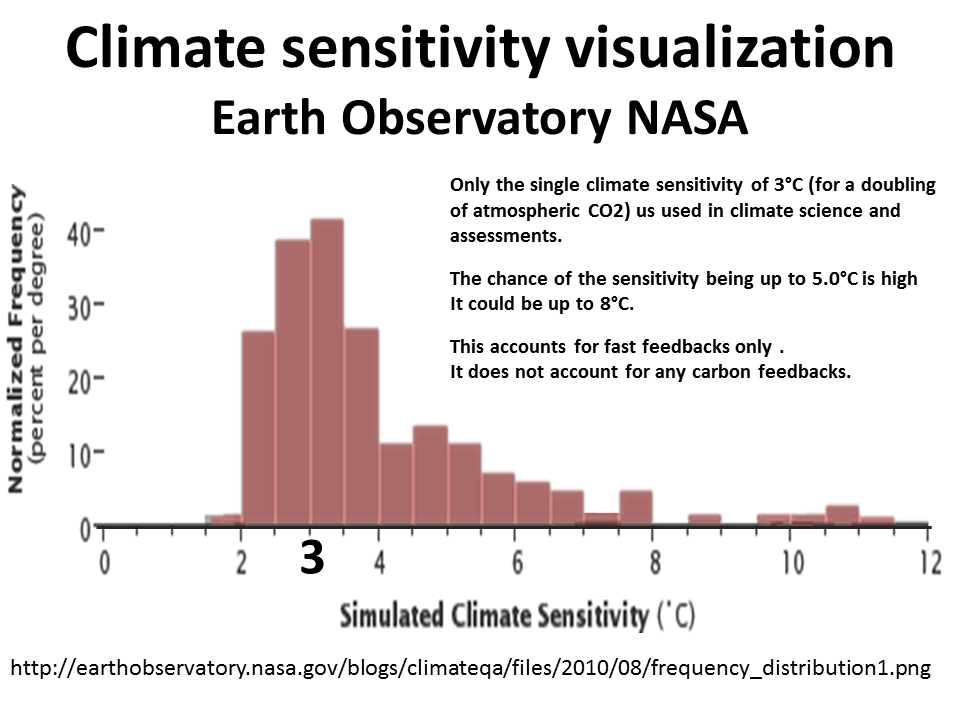
Climate science refers to two climate sensitivities (CS) results from models - called the 'transient' and 'equilibrium' sensitivity. IPCC AR5 WG1 SPM defines the equilibrium climate sensitivity as èthe response of the climate system to constant radiative forcing on multicentury time scales. It is defined as the change in global mean surface temperature at equilibrium that is caused by a doubling of the atmospheric CO2 concentration. Equilibrium climate sensitivity is likely in the range 1.5°C to 4.5°C (high confidence), extremely unlikely less than 1°C (high confidence), and very unlikely greater than 6°C.
However this assessment says no best estimate for equilibrium climate sensitivity can now be given because of a lack of agreement on values across assessed lines of evidence and studies.
The transient is the warming at the time of atmospheric stabilization from the 2X CO2. The equilibrium is the greater warming that occurs after the transient caused by the ocean heat lag (IPCC AR4 chart).
The first IPCC assessment referred to CS as both a doubling of CO2 and of CO2 equivalent. Now only CO2 is used, even though the GHGs contribute almost half the radiative heat forcing and global warming to date and according to the IPCC CO2 eq is about 100ppm higher than CO2 in isolation.
In the real world with more warming the sensitivity increases more than above due to extra warming from large sources of amplifying planetary feedbacks- carbon cycle feedbacks and albedo ice sheet feedbacks.
The climate sensitivity suggested by modern climate models may be fine for the short term, but does not encompass the full range of change expected in the long term…There are really two “sensitivities” involved: Climate sensitivity is what happens in the short term in response to a doubling of CO2. But the Earth system sensitivity is what happens in the longer time frame as ice sheets slowly melt, and as sea level slowly rises. The IPCC focuses on… the climate sensitivity – what will happen in the next 100 years. Earth system sensitivity tells you what happens in the next couple of hundred years after that. Dr Colin Summerhayes UK Gelogical Society Dec 2013.
Climate sensitivity is a key uncertainty for mitigation scenarios for specific temperature levels.Scenarios for specific temperature levels.
(IPCC AR4 2007 Synthesis report)
However this assessment says no best estimate for equilibrium climate sensitivity can now be given because of a lack of agreement on values across assessed lines of evidence and studies.
The transient is the warming at the time of atmospheric stabilization from the 2X CO2. The equilibrium is the greater warming that occurs after the transient caused by the ocean heat lag (IPCC AR4 chart).
The first IPCC assessment referred to CS as both a doubling of CO2 and of CO2 equivalent. Now only CO2 is used, even though the GHGs contribute almost half the radiative heat forcing and global warming to date and according to the IPCC CO2 eq is about 100ppm higher than CO2 in isolation.
In the real world with more warming the sensitivity increases more than above due to extra warming from large sources of amplifying planetary feedbacks- carbon cycle feedbacks and albedo ice sheet feedbacks.
The climate sensitivity suggested by modern climate models may be fine for the short term, but does not encompass the full range of change expected in the long term…There are really two “sensitivities” involved: Climate sensitivity is what happens in the short term in response to a doubling of CO2. But the Earth system sensitivity is what happens in the longer time frame as ice sheets slowly melt, and as sea level slowly rises. The IPCC focuses on… the climate sensitivity – what will happen in the next 100 years. Earth system sensitivity tells you what happens in the next couple of hundred years after that. Dr Colin Summerhayes UK Gelogical Society Dec 2013.
Climate sensitivity is a key uncertainty for mitigation scenarios for specific temperature levels.Scenarios for specific temperature levels.
(IPCC AR4 2007 Synthesis report)
Addendum Dec 2013, Climate Change Statement UK Geological Society
Climate sensitivity could be double
Climate sensitivity could be double
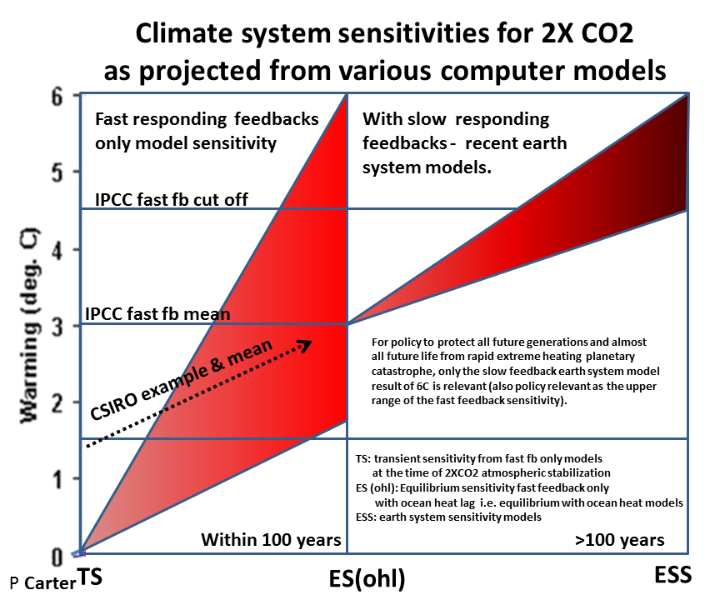
Nature: Spread in model climate sensitivity traced to atmospheric convective mixing 2014 climate sensitivity (fast feedback) is higher: 4 rather than 3.
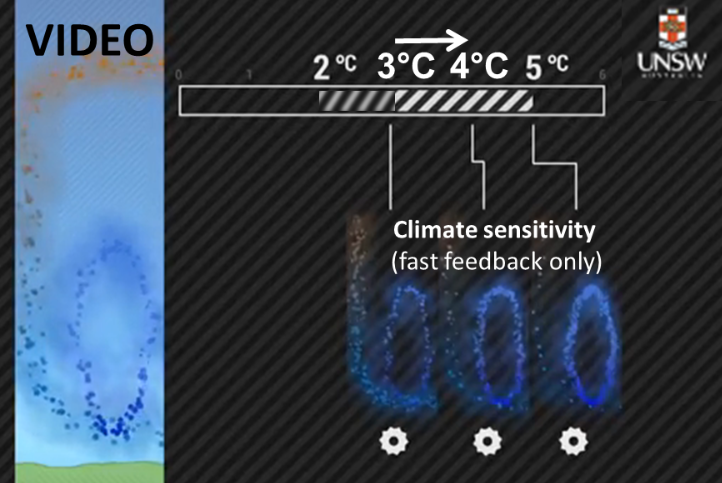
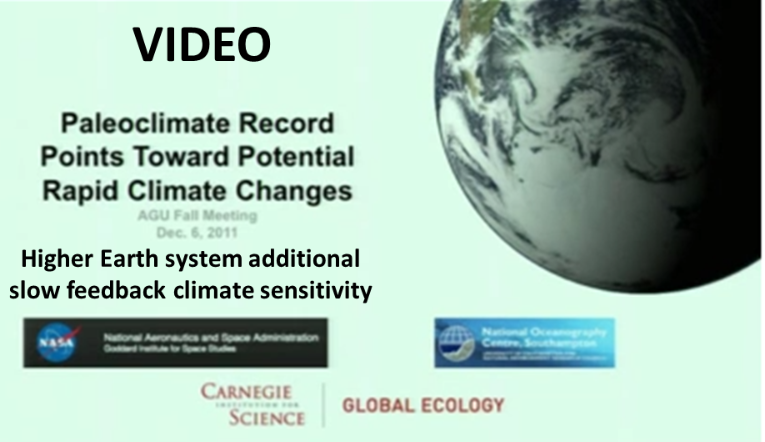
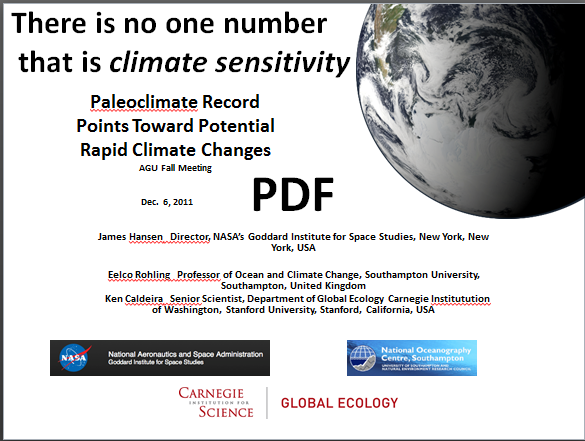
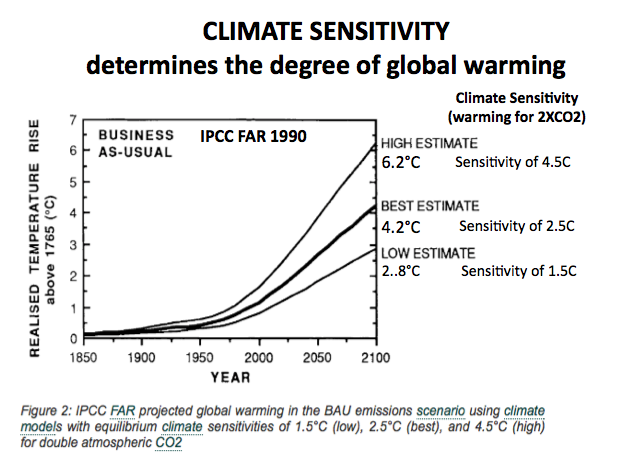
Recent research
25 June 2018 Palaeoclimate constraints on the impact of 2 °C anthropogenic warming and beyond (is double over the long term)
14 June Including the efficacy of land ice changes in deriving climate sensitivity from paleodata ECS=5.8C
8 April 2017 Observational constraints on mixed-phase clouds imply higher climate sensitivity ( 5 -5.3)
9 Nov 2016 Nonlinear climate sensitivity and its implications for future greenhouse warming
by date
4 Jan 2021 Greater committed warming after accounting for the pattern effect
Dec 2020 Improving long-term climate calculations CSens 5C (paper below)
11 Dec 2020 Multivariate Estimations of Equilibrium Climate Sensitivity From Short Transient Warming Simulations
22 July 2020 An assessment of Earth's climate sensitivity using multiple lines of evidence (just over 3C, cannot rule out above 4.5C)
26 May 2020 Short-term tests validate long-term estimates of climate change (high)
4 Jan 2021 Greater committed warming after accounting for the pattern effect
Dec 2020 Improving long-term climate calculations CSens 5C (paper below)
11 Dec 2020 Multivariate Estimations of Equilibrium Climate Sensitivity From Short Transient Warming Simulations
22 July 2020 An assessment of Earth's climate sensitivity using multiple lines of evidence (just over 3C, cannot rule out above 4.5C)
26 May 2020 Short-term tests validate long-term estimates of climate change (high)
Jan 2020 Causes of higher climate sensitivity in CMIP6 models 10 of 27 models >4.5C
Nov 2019 Extreme Sensitivity and Climate Tipping Points
Nov 2019 Extreme Sensitivity and Climate Tipping Points
Sept 2019 Earth to warm more quickly, new climate models show-by 2100, average temperatures could rise 7.0 degrees
18 Sept 2019
Simulation of Eocene extreme warmth and high climate sensitivity through cloud feedbacks: Sens 6C
August 2019 (Distant) Past Climate Sensitivity Not Always Key to the Future = 3.5°C to 5.5°C
July 2019 Most complete list. ESD Reviews: Climate feedbacks in the Earth system and prospects for their evaluation
July 2019 Most complete list. ESD Reviews: Climate feedbacks in the Earth system and prospects for their evaluation
28 June 2019 Latest Climate Model Points to Hotter Earth sensitivity 5.3C up from 3C.
22 Jan 2019 New calculations show scientists have grossly underestimated the cooling effects of air pollution.
25 June 2018 Palaeoclimate constraints on the impact of 2 °C anthropogenic warming and beyond (is double over the long term)
14 June Including the efficacy of land ice changes in deriving climate sensitivity from paleodata ECS=5.8C
8 April 2017 Observational constraints on mixed-phase clouds imply higher climate sensitivity ( 5 -5.3)
9 Nov 2016 Nonlinear climate sensitivity and its implications for future greenhouse warming
27 April 2016 Climate Sensitivity in the Geologic Past (>3C)
June 2016 (high) Deep time evidence for climate sensitivity increase with warming
June 2016 (high) Projection and prediction: Climate sensitivity on the rise
July 2016 Guardian recent research indicates higher sensitivity.
7 April 2016 Global warming may be far worse than thought, cloud analysis suggests. Climate change projections have vastly underestimated the role that clouds play, meaning future warming could be far worse than is currently projected, according to new research.
21 Dec 2015 NASA study: Examination of Earth's recent history - 70% higher sensitivity.
April 2015 Clouds are Amplifying Human Warming=higher climate sensitivity
March 2014 Climate
sensitivity at high end
of IPCC range
..forcing and transient
climate sensitivity
Drew T. Shindell
Jan 2014 The climate sensitivity of tropical ecosystems is increasing
(2X in 50 years and their ability to store carbon declining- a +ve feedback.
31 Dec 2013 Solution to cloud riddle reveals hotter future: Global temperatures to rise at least 4 degrees C by 2100
June 2016 (high) Deep time evidence for climate sensitivity increase with warming
June 2016 (high) Projection and prediction: Climate sensitivity on the rise
July 2016 Guardian recent research indicates higher sensitivity.
7 April 2016 Global warming may be far worse than thought, cloud analysis suggests. Climate change projections have vastly underestimated the role that clouds play, meaning future warming could be far worse than is currently projected, according to new research.
21 Dec 2015 NASA study: Examination of Earth's recent history - 70% higher sensitivity.
April 2015 Clouds are Amplifying Human Warming=higher climate sensitivity
March 2014 Climate
sensitivity at high end
of IPCC range
..forcing and transient
climate sensitivity
Drew T. Shindell
Jan 2014 The climate sensitivity of tropical ecosystems is increasing
(2X in 50 years and their ability to store carbon declining- a +ve feedback.
31 Dec 2013 Solution to cloud riddle reveals hotter future: Global temperatures to rise at least 4 degrees C by 2100

CLIMATE EMERGENCY INSTITUTE
The health and human rights approach to climate change
The health and human rights approach to climate change
NAP 2011 Earth's deep paleo past shows a very high climate sensitivity - up to 7 to 9.6C (+-1.5C , 3 M years ago (Pliocene).
Two 2015 NASA studies shows that short term sensitivity (and so long term) is 70% higher that the IPCC's estimates.
Two key papers (2011 and 2013) show that long term climate sensitivity is higher as it increases due to increasing amplifying climate feedbacks.
2011 M. Previdi Climate sensitivity in the Anthopocene
2013 R. Zeebe Time-dependent climate sensitivity and the legacy of anthropogenic greenhouse gas emissions. Warming will increase and last over 10,000 years.
Two key papers (2011 and 2013) show that long term climate sensitivity is higher as it increases due to increasing amplifying climate feedbacks.
2011 M. Previdi Climate sensitivity in the Anthopocene
2013 R. Zeebe Time-dependent climate sensitivity and the legacy of anthropogenic greenhouse gas emissions. Warming will increase and last over 10,000 years.
- The IPCC version of climate sensitivity (2X atmospheric CO2) is defined by a computer model projections.
- These model experiments are only run for about 200 years in general.
- They do not include any sudden increase of CO2.
- Obviously climate sensitivity is dependent on all atmospheric GHGs- not just CO2.
The policy relevant value would be emissions sensitivity to include the three main long lived GHG emissions.
Like other IPCC projections the models for projecting climate sensitivity do not account for the many large sources of amplifying feedback GHG emissions.
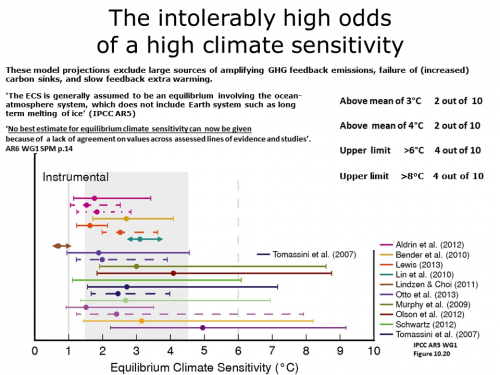
2017 Royal Society
Very slow changes in patterns of ocean surface warming are inadequately represented in time varying global climate models resulting in an underestimate of
climate sensitivity
Very slow changes in patterns of ocean surface warming are inadequately represented in time varying global climate models resulting in an underestimate of
climate sensitivity
Sept 2019Earth to warm more quickly, new climate models show-by 2100, average temperatures could rise 7.0 degrees Latest computer models give high climate sensitivities e.g. NCAR 5.3 instead of 3C for 2X CO2. Review of paleo climate science (10s to 100s millions years) also show higher sensitivity =3.5-5.5C
VIDEO 10 Dec 2019New Climate Model Predicts Alarming Levels of Global Heating
July 2019 Most complete list. ESD Reviews: Climate feedbacks in the Earth system and prospects for their evaluation

2019 Range of climate sensitivity research
For our future survival we had better that climate sensitivity is 6C, not 3C